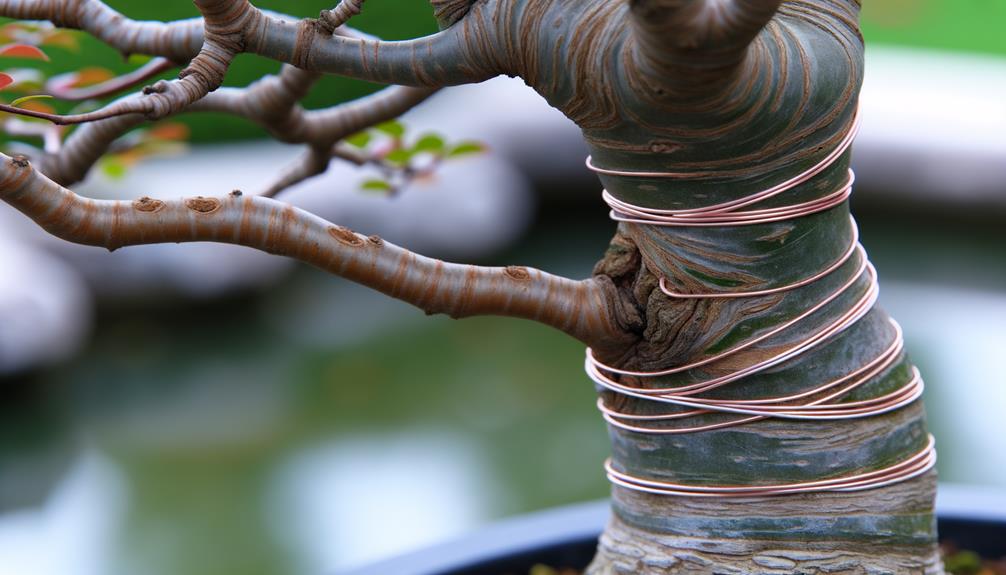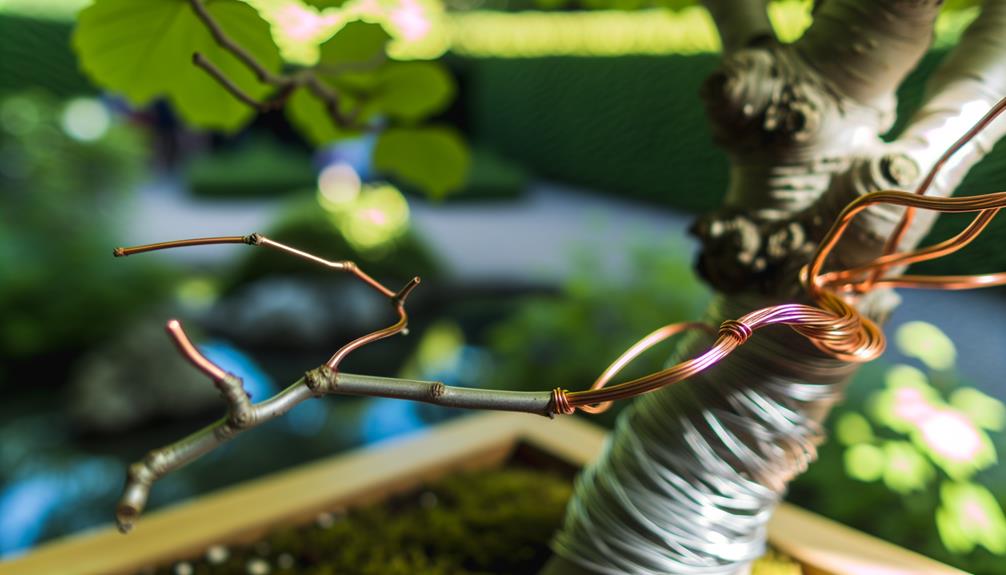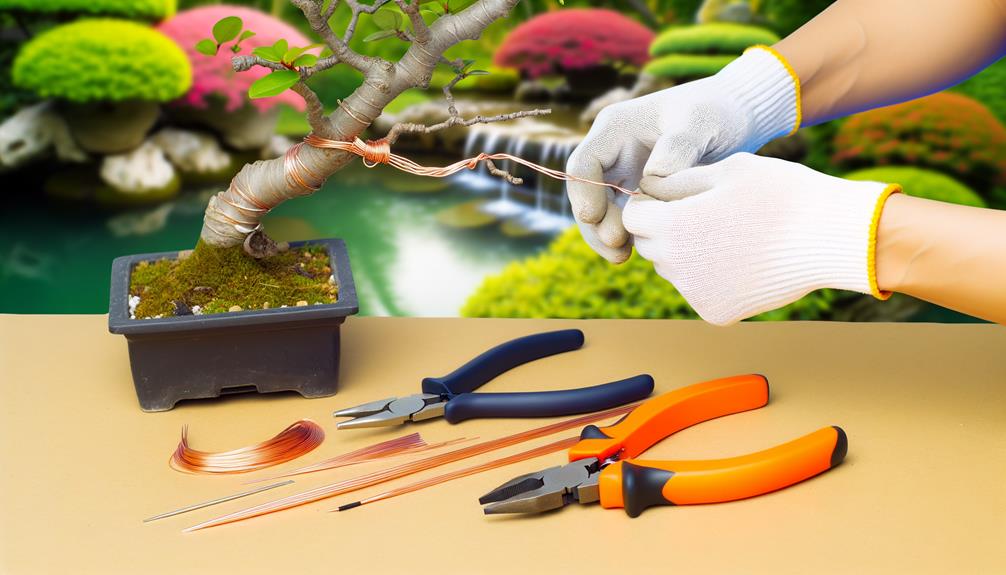How You Use Copper Wire for Bonsai: A Step-by-Step Guide
Yes, copper wire is highly effective for bonsai training. It offers exceptional tensile strength and malleability, allowing precise adjustments without breaking.
Copper's ability to oxidize helps it blend naturally with the bark, enhancing the tree's aesthetic value. Its superior durability makes it suitable for long-term use, especially in guiding heavier branches.
Annealed copper wire, being more flexible, minimizes stress on the plant, reducing the risk of damage. Proper application and monitoring are essential to prevent wire scars and safeguard the tree's health.
For a deeper understanding of species compatibility and wire maintenance, further information is available.

Key Takeaways
- Copper wire offers superior malleability and strength, making it ideal for training bonsai trees.
- Its conductive properties minimize stress on the plants during shaping and adjustments.
- Copper wire oxidizes to blend with tree bark, enhancing the bonsai's natural appearance.
- Available in various gauges, it allows for precise customization based on branch thickness and tree size.
- Annealed copper wire is more pliable and easier to work with, reducing potential damage to the tree.
Why Choose Copper Wire

Copper wire is widely favored in bonsai cultivation due to its superior malleability and strength, which allow for precise and durable shaping of tree branches. The unique properties of copper, including its ability to hold shape well over time, make it an ideal material for training bonsai trees.
This metal's conductive properties also guarantee minimal stress on the plant, as it efficiently disperses heat and electrical currents. Additionally, copper wire oxidizes to a dull brown over time, blending seamlessly with the tree's bark, which maintains the aesthetic integrity of the bonsai.
Its availability in various gauges further permits customization based on the specific requirements of different tree species and branch thicknesses, making it a versatile choice for bonsai enthusiasts.
Strength and Malleability
The exceptional strength and malleability of copper wire make it an essential tool in the meticulous art of bonsai training. Copper wire offers superior tensile strength, allowing it to hold branches in desired positions more effectively than other materials. This characteristic is vital for shaping and maintaining intricate bonsai forms.
Additionally, copper wire is highly malleable, meaning it can be easily bent and twisted without breaking. This flexibility facilitates precise adjustments, enabling horticulturists to guide growth patterns meticulously. When annealed, copper wire becomes even more pliable, enhancing its usability for intricate designs and complex structures.
These properties guarantee that copper wire remains a favored choice among bonsai enthusiasts seeking both durability and adaptability in their craft.
Wire Scars and Prevention

Preventing wire marks is vital in bonsai training to maintain the aesthetic integrity and health of the tree. Wire marks can occur when the wire is left on too long or applied too tightly, restricting growth and damaging the bark. Monitoring the tree regularly and adjusting or removing wire as needed is essential. Employing proper wiring techniques and selecting the appropriate wire gauge for the tree's size can also reduce risks.
| Action | Effect |
|---|---|
| Frequent Monitoring | Early detection of tight wires |
| Proper Wire Selection | Minimizes excessive pressure |
| Correct Application | Ensures even distribution of force |
| Timely Removal | Prevents long-term damage |
Using these strategies, bonsai enthusiasts can guarantee their trees develop beautifully without unsightly marks.
Annealed Vs. Non-Annealed
In bonsai training, understanding the differences between annealed and non-annealed wire is vital for optimizing tree shaping and minimizing damage.
Annealed copper wire has undergone a heat treatment process, which increases its flexibility and reduces its hardness. This makes it more malleable and easier to apply without causing undue stress to the tree.
Non-annealed wire, in contrast, retains its natural hardness and rigidity, which can lead to increased risk of bark damage and scarring.
- Flexibility: Annealed wire is more pliable, making it easier to manipulate.
- Stress Reduction: Reduced hardness minimizes the risk of tree damage.
- Reusability: Non-annealed wire is less likely to be reusable due to its rigidity.
- Application Ease: Annealed wire provides smoother application, especially for beginners.
This distinction is fundamental for effective bonsai artistry.
Comparing Copper and Aluminum

When comparing copper and aluminum wire for bonsai, it is important to evaluate their strength and flexibility, as these properties greatly impact tree shaping.
Additionally, the susceptibility of each metal to oxidation and corrosion must be considered, as this affects both the longevity of the wire and the health of the bonsai.
Understanding these differences enables bonsai enthusiasts to make informed decisions based on specific horticultural requirements.
Strength and Flexibility
The comparative examination of copper and aluminum wire reveals that copper demonstrates superior strength under tension and flexibility, making it more effective for shaping and supporting bonsai trees.
The improved characteristics of copper wire offer several benefits:
- Higher Strength Under Tension: Copper can withstand greater stress without fracturing, necessary for preserving intricate bonsai shapes.
- Improved Flexibility: Copper can be shaped and contorted more delicately, allowing for accurate modifications.
- Better Retention Capability: Copper's stiffness ensures branches remain in position once adjusted, enhancing long-term stability.
- Greater Load-bearing Capacity: Copper can bear heavier branches, essential for larger or older bonsai specimens.
These qualities make copper wire a favored option for bonsai enthusiasts striving for precise and long-lasting tree shaping.
Oxidation and Corrosion
Copper wire, frequently utilized in bonsai cultivation, displays remarkable resistance to oxidation and corrosion in comparison to aluminum, making it a more resilient option for long-term use.
Copper's natural patina, developed through oxidation, serves as a protective layer, preventing further deterioration. This characteristic ensures that copper wire retains its structural integrity and appearance over time, even when exposed to moisture and varying environmental conditions.
In contrast, aluminum wire, although more resistant to corrosion than many other metals, lacks a similar protective oxidation layer. Aluminum can become brittle and degrade faster when exposed to elements, potentially compromising the bonsai's structural support.
Consequently, copper's superior resistance to oxidation and corrosion highlights its preference among bonsai enthusiasts for enduring applications.
Proper Wiring Techniques
Achieving best outcomes in bonsai shaping requires precise application of wiring techniques, making sure the wire is neither too tight nor too loose around the branches. Proper wiring promotes prime growth direction and structural integrity.
Key steps include:
- Wire Selection: Choose a wire gauge that is one-third the thickness of the branch.
- Anchor Points: Secure the wire to a stable branch or the trunk to guarantee stability.
- Angle and Spacing: Wrap the wire at a 45-degree angle, maintaining consistent spacing to avoid constricting growth.
- Monitoring and Adjustment: Regularly check and adjust the wire to prevent it from cutting into the bark as the branch thickens.
Attention to detail in these areas ensures healthy, aesthetically pleasing bonsai development.
Seasonal Considerations

Considering the seasonal growth patterns of bonsai trees is important for effective wiring and overall health management.
During the spring and summer months, when active growth occurs, copper wire should be applied with care due to the increased risk of wire biting into the expanding bark.
Conversely, the dormant winter period is best for wiring, as the tree's growth slows, reducing the likelihood of damage. Additionally, the cooler temperatures during winter minimize stress on the tree, allowing it to better acclimate to the shaping process.
Monitoring environmental conditions such as humidity and temperature is vital, as these factors influence the tree's response to wiring. Proper timing and seasonal awareness ensure the long-term health and structural integrity of the bonsai.
Tree Species Compatibility
When selecting tree species for bonsai, it is important to take into account their compatibility with copper wiring techniques. Certain species, such as pines, junipers, and maples, respond well to the rigidity and support provided by copper wire, while others may be more sensitive to potential bark damage or wire marks.
Additionally, understanding the specific growth patterns and bark characteristics of each species can mitigate concerns related to copper wire usage, ensuring best shaping and health of the bonsai.
Suitable Bonsai Species
Understanding the compatibility of various tree species with copper wire is important for effective bonsai training, as different species exhibit varied responses to wiring techniques. The malleability and conductivity of copper make it particularly suitable for species with specific growth patterns and bark textures.
- Conifers: Species such as Junipers and Pines are highly suitable due to their flexible branches and robust bark.
- Deciduous Trees: Maples and Elms respond well to copper wiring, although care must be taken to avoid wire marks.
- Flowering and Fruiting Trees: Trees like Azaleas and Apples require delicate handling but benefit from precise shaping using copper wire.
- Tropical Species: Ficus and Bougainvillea can also be wired with copper, though monitoring is important to prevent damage.
Proper species selection ensures best results in bonsai artistry.
Copper Wire Concerns
The use of copper wire in bonsai training requires careful consideration of each tree species' unique physiological responses to promote growth and minimize damage.
Certain species, such as pines and junipers, respond favorably to copper wiring due to their resilient bark and flexible branches.
Conversely, deciduous species, including maples and elms, exhibit sensitivity to copper, which can cause bark scarring and hinder growth.
The wire's malleability and strength must be balanced against potential risks, as improper application can result in constriction and impaired vascular function.
Understanding the specific tolerances and responses of different species is essential for effective bonsai training, ensuring that the aesthetic goals are met without compromising the tree's health and well-being.
Removing Copper Wire

Proper removal of copper wire from bonsai trees is essential to prevent harm to the bark and underlying structures. This meticulous process requires attention to detail and proper tools to guarantee the tree's health and aesthetic integrity.
Key steps include:
- Timing: Remove the wire before it starts to bite into the bark, typically after 6-12 months.
- Tools: Utilize specialized wire cutters to avoid crushing the branches.
- Technique: Carefully cut the wire at multiple points and gently unwind it, rather than pulling or yanking.
- Inspection: Regularly inspect the tree for any signs of wire scars or stress, addressing issues promptly.
Following these best practices secures the tree's continued growth and minimizes potential damage.
Reusing Copper Wire
Reusing copper wire in bonsai cultivation presents significant advantages by mitigating environmental impact through reduced waste and promoting cost efficiency.
The inherent durability of copper wire allows multiple cycles of use without significant degradation in performance.
This practice not only supports sustainable horticulture but also guarantees economical resource management for bonsai enthusiasts.
Environmental Impact
Utilizing copper wire for bonsai cultivation can greatly reduce environmental waste by promoting the reuse of a durable and recyclable material. Copper wire possesses several ecological benefits:
- Longevity: Copper wire can be reused multiple times without significant degradation, minimizing the need for new materials.
- Recyclability: Copper is easily recyclable, reducing the extraction of new resources and lowering environmental impact.
- Reduced Waste: By reusing copper wire, bonsai enthusiasts contribute to decreased landfill waste and a more sustainable practice.
- Energy Efficiency: Recycling copper requires less energy compared to producing new copper, thereby reducing greenhouse gas emissions.
Adopting copper wire for bonsai practices not only aids in plant shaping but also aligns with environmentally responsible gardening techniques.
Cost Efficiency
Employing copper wire in bonsai cultivation proves to be cost-effective, as its durability and reusability reduce the frequency of purchasing new materials. Copper wire, once used, can be carefully unwrapped and stored for future applications. This reusability is a significant financial advantage, especially for long-term bonsai practitioners.
Moreover, the initial investment in copper wire is offset by its longevity, as it retains its structural integrity over multiple uses. This characteristic minimizes the need for frequent replacements, thereby lowering overall costs.
In addition, copper wire's ability to be annealed and reshaped multiple times without compromising its tensile strength makes it an excellent choice for both novice and experienced bonsai artists seeking a sustainable and economical wiring solution.
Wire Durability
Copper wire's durability allows it to be repeatedly reshaped and reused without losing its structural integrity, making it an invaluable tool in bonsai cultivation. Its metallurgical properties guarantee it retains tensile strength and elasticity even after multiple uses. This endurance offers several practical benefits:
- Cost efficiency: Reduced need for frequent replacement translates to long-term savings.
- Environmental impact: Lower consumption results in decreased waste and less strain on resources.
- Consistent performance: Maintains uniform tension and support for best plant shaping.
- Versatility: Can be utilized for various bonsai sizes and species due to its adaptable nature.
These attributes underscore why copper wire is a preferred choice among bonsai enthusiasts, ensuring both sustainability and reliability in their horticultural practices.
Safety Precautions

When using copper wire for bonsai, it is crucial to wear protective gloves to prevent cuts and abrasions. Copper wire, while malleable, can have sharp edges that pose a risk to the skin.
Besides, prolonged exposure to copper can cause skin irritation for some individuals. Safety goggles are also recommended to protect the eyes from potential wire fragments.
It is essential to use wire cutters specifically designed for copper to guarantee clean cuts and avoid frayed edges.
Working in a well-ventilated area also helps to make sure that any microscopic particles released during the process do not pose respiratory hazards.
Adhering to these safety precautions minimizes the risk of injury and ensures a safe and effective bonsai wiring process.
Expert Tips and Tricks
Having addressed the necessary safety precautions, experienced bonsai practitioners often recommend annealing copper wire to enhance its flexibility and workability. Annealing involves heating the wire to a specific temperature and then allowing it to cool slowly, which reduces internal stresses and makes the wire easier to manipulate.
Here are some expert tips and tricks for using annealed copper wire effectively:
- Diameter Selection: Choose the appropriate wire diameter based on branch thickness to guarantee sufficient support without harming the bark.
- Wrapping Technique: Apply the wire at a 45-degree angle to distribute pressure evenly and avoid constriction.
- Monitoring: Regularly check for wire marks or girdling, adjusting as necessary to prevent permanent damage.
- Seasonal Timing: Wire during the dormant season to reduce stress and improve training outcomes.
These tips ensure best possible results in bonsai wire training.
Conclusion
Copper wire is highly suitable for bonsai due to its strength, malleability, and ability to retain shape. However, precautions must be taken to prevent wire scars, particularly when using non-annealed wire. Comparative analyses reveal copper's superior strength over aluminum, though challenges in removal and potential for reuse exist.
Safety guidelines must be strictly followed. For instance, an experienced bonsai artist successfully shaped a delicate juniper using annealed copper wire, emphasizing the wire's efficacy when properly managed.






